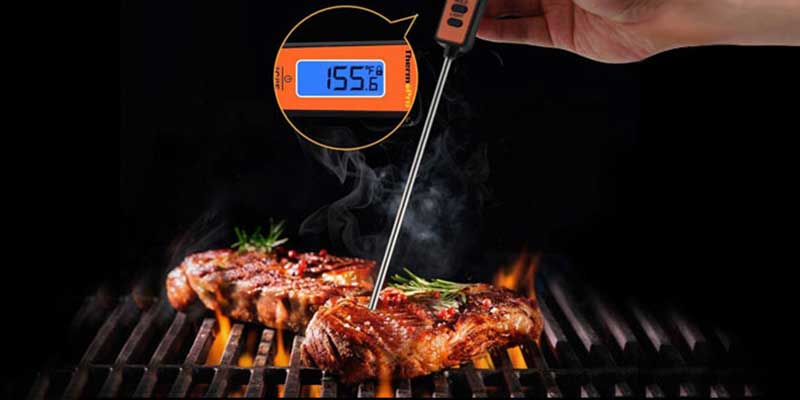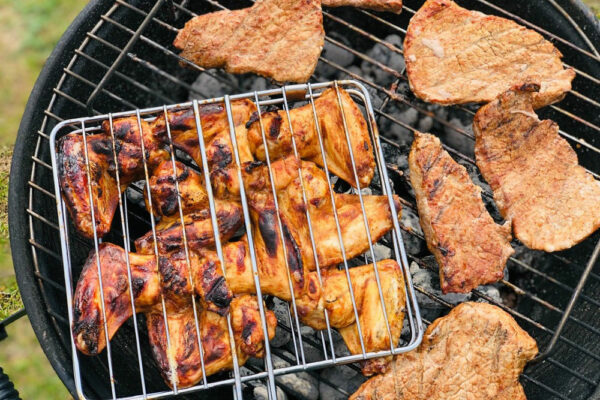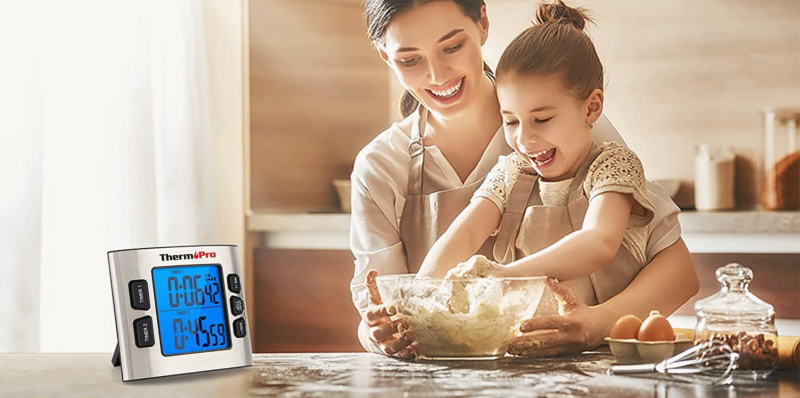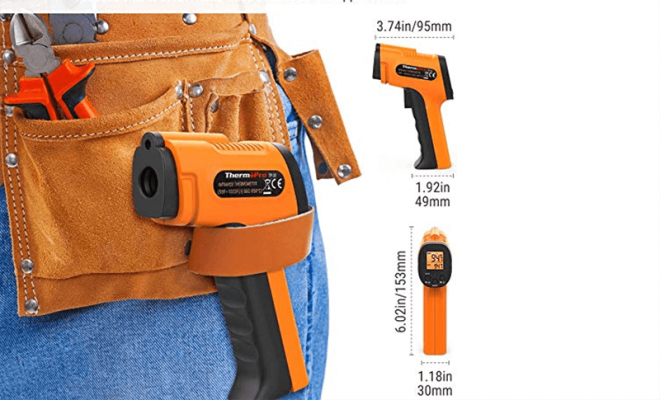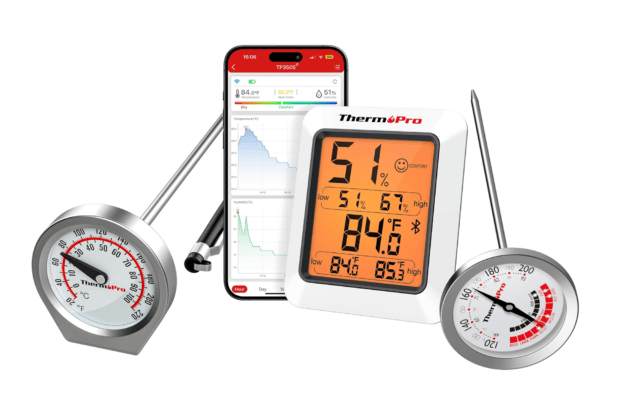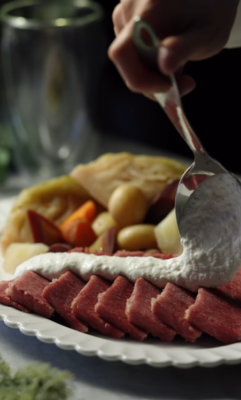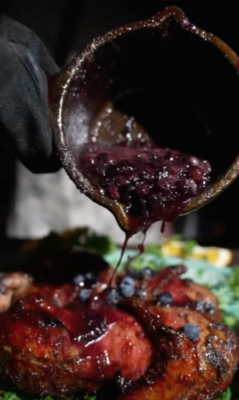Table of Contents
Cooking with a digital cooking thermometer and/or a wireless cooking thermometer provides more precise heat control and greater food safety. You can cook meats to order and complex foods like hard candy-like the pros do. Using a thermometer for cooking is easy once you understand the process.
Some cooks like to cook on the grill, and others prefer to control caramelization and temperature more accurately with stovetop searing and baking at a preset temperature. Regardless of how you like to cook, a little knowledge and the right cooking thermometer can transform your results into foods that rival the best professional chef’s dishes.
Meat Meets Its Master
When you use the right thermometer, you become the meat master. A thermometer is just a tool. It’s your decision to use a meat thermometer every time you cook that guarantees consistent results and perfect food where the dangers of undercooked chicken, pork, beef or seafood never arise.
Any thermometer, when used properly, can help an amateur or experienced chef cook meat to order with incredible results. Experienced cooks can often achieve the same results by judging doneness by the meat’s texture, color, smell and other criteria.
However, accuracy can depend on meat thickness, oven and cooking element temperature accuracy and the temperature of coals for charcoal grilling. Stuff happens when cooking, but thermometers can prevent serious danger.
When you want to be accurate – especially for cuts of meat you haven’t cooked before – the ThermoPro Meat Thermometer offers digital and wireless models of meat thermometers that deliver pinpoint accuracy. Here’s what you should know about placing the probe in meat thermometers:
- If the meat is shaped irregularly, test the temperature in several areas.
- Don’t forget to include standing time to allow juices to redistribute juices throughout the meat and the meat to complete the cooking process.
- You can bake steaks in the oven with great temperature control if you first sear the meat on top of the stove to get good caramelization.
- Pork and chicken can be very dangerous if undercooked.
- Place the thermometer probe in the thickest part of the meat with the tip as near the center as possible.
- Thermometer tips should not touch fat or bone.
- Check poultry in the thickest part of the thigh, and make sure the temperatures reaches 165-degrees Fahrenheit.
Types of Cooking Thermometers
The types of kitchen thermometers include instant-read thermometers, cooking timers, digital forks and digital wireless thermometers. There are single-use thermometers, liquid-filled thermometers and oven-safe bimetal thermometers for taking temperatures over a short period of time or instant-read temperatures that appear when the thermometer is inserted into food.
Thermocouples rank among the fastest thermometers because they give a reading in 2 to 5 second, a big benefit in a busy commercial kitchen. The fine wires at the tip of the screen display the average temperature between the tips. Instant-read digital thermometers are the simplest to use – all you need to do is place the probe in the food, wait a few seconds and check the temperature.
Food Safety
Food safety is the primary reason that people use cooking thermometers because the readings ensure that a safe temperature has been reached to kill dangerous bacteria and foodborne pathogens. The temperatures for food safety include the following guidelines published by the USDA.
- Beef, Pork, Veal and Lamb – Steaks, chops and roasts must reach an internal temperature of 145 degrees. Ground meets must reach 160 degrees. Hams must be cooked to 140 degrees if processed in USDA-inspected plants, but the temperature must be 165 degrees if the ham was processed in another plant without USDA inspection.
- Poultry – All poultry must be cooked to 165 degrees.
- Eggs – Eggs must be cooked to 160 degrees for safety, but it’s difficult to take the temperature of an egg. Preferences for over-easy, soft-scrambled and soft-boiled eggs also complicate the problem.
- Fish and Shellfish – Fruits of the sea – fish and shellfish – must be cooked to 145 degrees.
- Leftovers, Casseroles and Multiple-ingredient Dishes – The safe temperature for all foods is 165 degrees.
The USDA chart doesn’t take into account people’s preferences for rare steaks, but steaks are safe at 145 degrees. Rare steaks usually register at 125 degrees and have cool pink centers. Medium rare steaks have warm pink centers and register at 135 degrees. Medium steaks register at 145 degrees, which is the safe temperature for cooked beef.
Some people prefer their steaks well done, which is defined by a temperature of 160 degrees and higher for extremely well-done meat. Steaks should be removed from heat when they’re still at a temperature 5 degrees lower than the target. High-quality steaks – such as Angus and Kobe – have different cooking times and temperatures.
Tips and Tricks to Use a Digital Cooking Thermometer

The first thing that you need to understand is that the best cooking thermometer is digital because these instruments give instant readings. Temperatures can change considerably in just a short time, and while you’re waiting for a traditional thermometer to level off, you could ruin many dishes where precise temperatures are essential.
Meat thermometers have many models, and style is often an important aspect of choosing a thermometer for a cool grill king or queen. You can choose from single-probe or multiple-probe models, which are great for taking the temperature of racks of ribs, sides of beef and whole roasted pigs with probes inserted into multiple areas.
Wireless cooking thermometers are even better for monitoring temperatures of problematic foods – which seem to include most foods being cooked these days. Stovetop cooking can dislodge traditional thermometers from the side of the saucepan where they can come in contact with metal and throw off readings. They can also get stuck in quickly hardening candy, so a temperature probe thermometer is a better option for candy making.
Infrared thermometers are useful in busy kitchens where cooks need to check the temperatures of multiple foods on top of the stove. Infrared thermometers, however, only measure the surface temperatures of food. That’s why it’s important to stir these foods to remove hot and cold spots.
Monitoring food temperature in ovens accurately is impossible without a digital and/or wireless thermometer. Sometimes, it’s necessary to cool certain foods before proceeding to the next step, and wireless thermometers make it easier to monitor food temperature inside a refrigerator, freezer or walk-in cooler.
Secret Sauce Secrets that Companies and Chefs Won’t Explain
Despite cordial relations with competitors and strong interest in new foods, farm-to-table service and kitchen gadgetry, most chefs and home cooks are jealous people who guard their secret recipes, cooking techniques and special suppliers. Most chefs won’t lie about a recipe, but they will withhold critical information.
One of the most common ways to lie is to give people the technical information about the stages of candy making without any explanation of the process to put things in perspective. For example, chefs and recipes will tell you to cook sugar syrup to 300 to 310 degrees, the hard crack stage. However, they won’t say how long this will take or what “hard crack” means. Hard crack stage means sugar has cooked to the point where a little syrup added to cold water become brittle like peanut brittle.
Guess what happens when an enthusiastic amateur chef tries to make pralines. The chef puts the butter, sugar and milk on to boil, but the thermometer seems to stick at the temperature of the boiling point of water. That’s because the syrup is mostly water until enough moisture evaporates for the temperature to rise. This usually takes an astonishing 10 to 15 minutes, and by this time, most cooks have given up hope of ever understanding the candy-making process.
Clip-on thermometers are nearly impossible to use when you must stir a sugar mixture constantly to prevent scorching in the latter stages of making a confection like pralines. Temperatures in heavy metal cookware continue to rise after removal from the heat, so tricky confections might need to be removed from the heat source a minute or two early.
Ever hear of preacher cookies, the no-bake staple of rural families years ago? Rumor has it that families could see the preacher’s carriage miles off, which gave the lady of the house just enough time to make these no-bake cookies of peanut butter, chocolate, sugar and oatmeal. However, the recipes don’t explain that the cookies won’t harden if you don’t cook them enough, and they will become hard and inedible if you overcook the syrup of butter, sugar, cocoa and milk. By the way, the right temperature is just above 190 degrees, but don’t let the mixture boil for best results.
Final Thoughts
The best cooking thermometer is one that you use, calibrate and keep clean to prevent the buildup of bacteria, which can damage temperature readings. If the technology is too complex for your freewheeling style, you might prefer an old-fashioned liquid-filled thermometer, a disposable thermometer or a durable bimetal thermometer that you can use in the oven, on the grill and to take the temperature of your favorite pan sauce. Why not just try one of the following best cooking thermometers 2019 to cook like a pro?
-
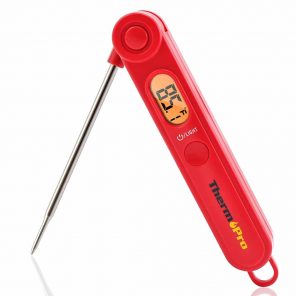 ThermoPro TP03$15.99 $16.95Rated 4.92 out of 5 based on 320 customer ratings
ThermoPro TP03$15.99 $16.95Rated 4.92 out of 5 based on 320 customer ratings

